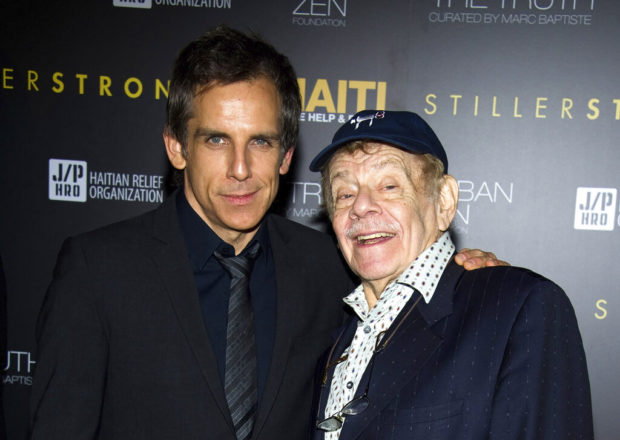NEW YORK — Comedy veteran Jerry Stiller, who launched his career opposite wife Anne Meara in the 1950s and reemerged four decades later as the hysterically high-strung Frank Costanza on the smash television show “Seinfeld,” died at 92, his son Ben Stiller announced Monday.

In this Feb. 11, 2011, photo, Ben Stiller, left, and his father Jerry Stiller arrive at the Help Haiti benefit honoring Sean Penn hosted by the Stiller Foundation and The J/P Haitian Relief Organization, in New York. AP Photo/Charles Sykes, File
He died of natural causes, his son — a comedy star himself — said in a tweet.
Jerry Stiller was a multi-talented performer who appeared in an assortment of movies, playing Walter Matthau’s police sidekick in the thriller “The Taking of Pelham One Two Three” and Divine’s husband Wilbur Turnblad in John Waters’ twisted comedy “Hairspray.”
He also wrote an autobiography, “Married to Laughter,” about his 50-plus year marriage to soul mate and comedic cohort Meara, who died in 2015. And his myriad television spots included everything from “Murder She Wrote” to “Law & Order” — along with 36 appearances alongside Meara on “The Ed Sullivan Show.”
Stiller, although a supporting player on “Seinfeld,” created some of the Emmy-winning show’s most enduring moments: co-creator and model for the “bro,” a brassiere for men; a Korean War cook who inflicted food poisoning on his entire unit; an ever-simmering salesman controlling his explosive temper with the shouted mantra, “Serenity now!”
Stiller earned an 1997 Emmy nomination for his indelible “Seinfeld” performance. In a 2005 Esquire interview, Stiller recalled that he was out of work and not the first choice for the role of Frank Costanza, father to Jason Alexander’s neurotic George.
“My manager had retired,” he said. “I was close to 70 years old, and had nowhere to go.”
He was initially told to play the role as a milquetoast husband with an overbearing wife, Estelle, played by Estelle Harris. But the character wasn’t working — until Stiller suggested his reincarnation as an over-the-top crank who matched his wife scream for scream.
It jump-started the septuagenarian’s career, landing him a spot playing Vince Lombardi in a Nike commercial and the role of another over-the-top dad on the long-running sitcom “King of Queens.”
While he was known as a nut-job father on the small screen, Stiller and wife Meara raised two children in their longtime home on Manhattan’s Upper West Side: daughter Amy, who became an actress, and son Ben, who became a writer, director and actor in such films as “Dodgeball,” “There’s Something About Mary” and “Meet the Parents.”
He and Ben performed together in “Shoeshine,” which was nominated for a 1988 Academy Award in the short subject category.
Stiller was considerably quieter and reflective in person than in character — although just as funny. The son of a bus driver and a housewife, Stiller grew up in Depression-era Brooklyn. His inspiration to enter show business came at age 8, when his father took him to see the Marx Brothers in the comedy classic “A Night at the Opera.”
Years later, Stiller met Groucho Marx and thanked him.
Stiller earned a drama degree at Syracuse University after serving in World War II, and then headed to New York City to launch his career. There was a brief involvement in Shakespearean theater, including a $55 a week job with Jack Klugman in “Coriolanus.”
But his life and career took off after he met Meara in spring 1953. They were married that fall.
The seemingly mismatched pair — he a short, stocky Jewish guy from Brooklyn, she a tall, Irish Catholic from the Long Island suburbs — shared an immediate onstage chemistry, too. They were soon appearing on “The Ed Sullivan Show” and working nightclubs nationwide.
The pair also wrote and performed radio commercials, most memorably a series of bits for a little-known wine called Blue Nun. The duo’s ads boosted sales by 500%. Ben Stiller recalled trips with his sister to California when his parents would head west to do television appearances.
The couple went on to appear as a team in dozens of film, stage and television productions. One of them was “After-Play,” a 1995 off-Broadway show written by Meara.
Stiller joined “Seinfeld” in 1993, and moved on to “King of Queens” when the other Jerry & company went off the air in 1998. He also appeared in Ben Stiller’s spoof on modeling, “Zoolander,” released in 2001.